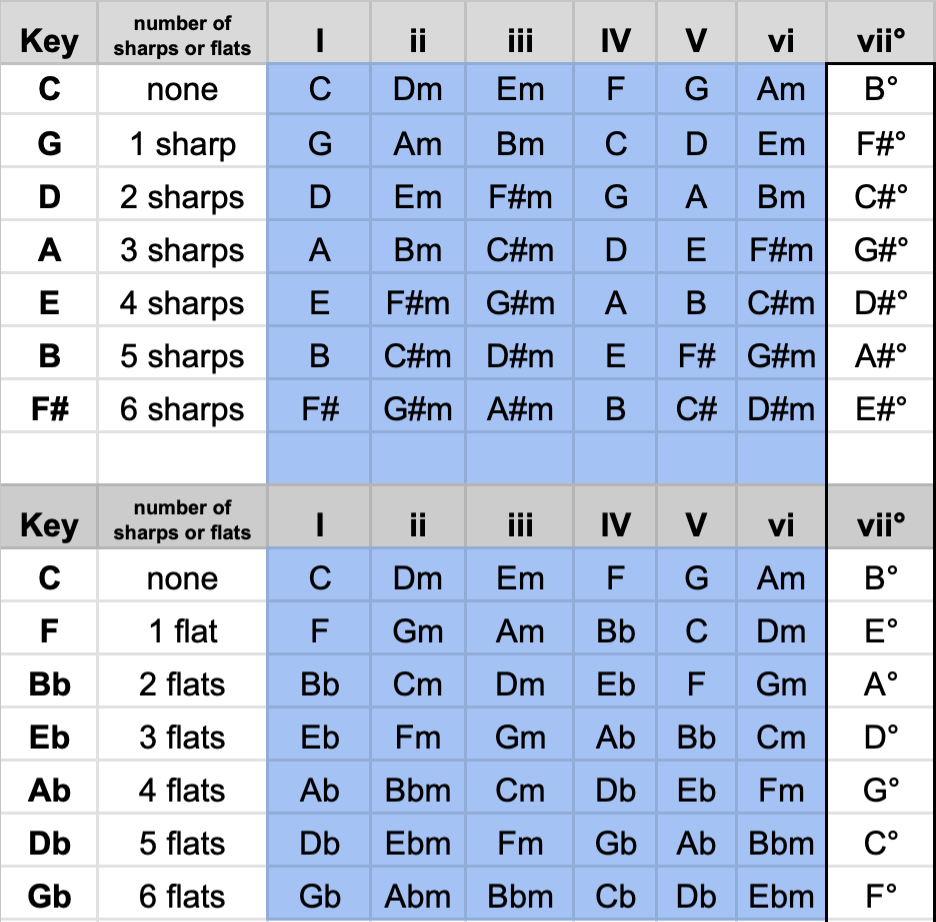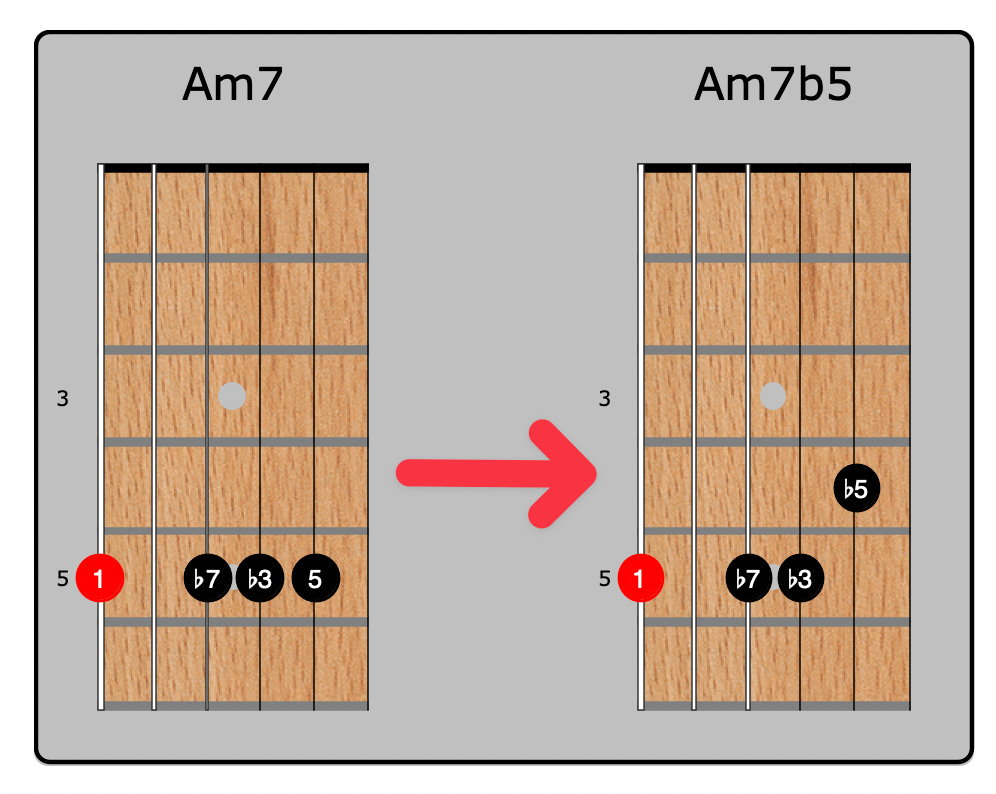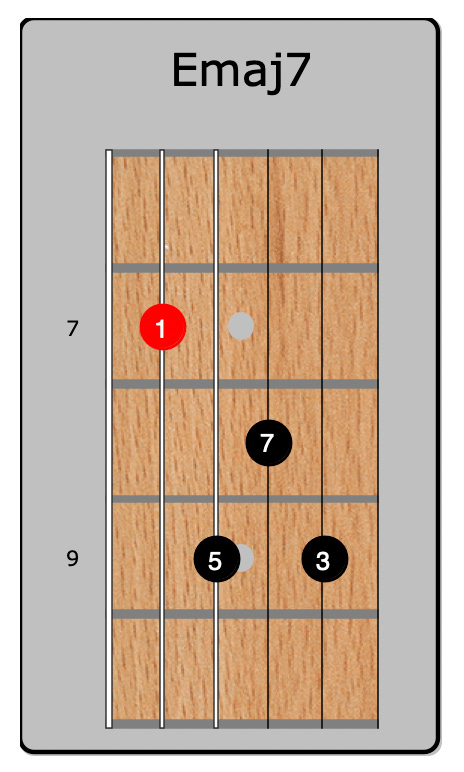The 🟢 Start Here Series
In Part One, we gave names to the sections of songs—verse, chorus, etc
In Part Two, we talked about our musical ruler of time: beats & bars.
In Part Three, we looked at our musical ruler for pitch: the major scale
Here in part four, we’ll take a deeper look at chords.
👉 Also: don’t forget to check out the missing manual for music’s most important skill.
Last week we talked about the major scale.
We saw how it’s the “measuring stick” for western music:
We saw that chords are built by stacking every other note…
…and that these flavors of chord show up in the same order in every key:
This week we’ll look at chords that break from the expected.
Weird chords are fun.
Am7♭5. Emaj9. G9♯11. F/G.
All of these spicy chords have little lessons to teach us. Let’s start with the basics.
Two rules for naming chords:
The major scale is our ruler, and
every chord is the center of its own universe.
In other words:
We describe everything in relation to the major scale, and
we measure from the chord’s root (and not the key’s root).
So this is an Am7:
This chord shows up diatonically the keys of C, G, & F…
…but that doesn’t matter!
That’s because we measure from the chord’s root note—the A.
(And the chord’s root is the same no matter what key we’re in.)
Notice those scale degrees—♭3 and ♭7.
We measured these from the major scale—they’re a half-step (one fret) below the 3 and the 7.
To drive this idea home, let’s modify our Am7 into an Am7♭5:
Do you see how we lowered the 5 to get the ♭5?
That’s the basic idea: learn to describe chord tones by degree, and you’ll be able to build (or name) every chord ever.
These ten E chords will show you how
Start with this “C shaped” E chord:
Notice how the root (the “1”) is redundant?
Redundant notes are super common in guitar chord voicings. They beef up the sound & make it easier to strum.
Redundant notes are usually the first ones we replace when building spicier chords. For example…
A half-step (one fret) below the root is the 7…
…and 1 3 5 7 = a major 7 chord:
If you had a short-scaled guitar and really long fingers, you could “flat the seven” by dropping that down one more fret:
Luckily for us, there’s a far friendlier alternative:
You’ll notice that our redundant root is back…
…and that we’ve ditched the 5 to make room for the ♭7.
That’s ok—the 5 adds some nice heft to a chord voicing, but it’s not as important as the root, the 3rd, or the fun extensions (like the ♭7)
The addition of that ♭7 makes this a “dominant chord”—E7.
We’ll review all the different 7 chords in a minute, but first let me show you this…
We took that redundant root and replaced it with the 2…
…but now the 2 is called the 9?!? 😬
If the chord name has 9, 11, or 13, it’s telling us it has the 7 too.
An easy way to remember this:
9 = 7 + 2
11 = 7 + 4
13 = 7 + 6
For example:
Emaj9 = Emaj7 chord + the 2
Em9 = Em7 chord + the 2
Em11 = Em7 chord + the 4
E13 = E7 chord + the 6
Let’s do one more chord-naming convention: alterations.
9, 11, or 13 implies that the 7 is also present…
…so we don’t usually have to write 7 in the name of an “extended” chord…
…except when the “extensions” (9, 11, 13) are “altered” (♯’d or ♭’d).
Geez! What a word salad! Why so many arbitrary rules?
This is one is actually pretty simple:
Writing the 7 in the chord name separates the ♯s & ♭s from the root:
E♭9 is built from the root note of E♭, and
E7♭9 is built from the root note of E (it’s the 9 that’s flatted).
This is important! If I write “E♭9” when I actually mean “E7♭9”, the keyboard player & I are collectively gonna play this awful sounding mess:
This might help
Here’s a visual to help you make sense of the whole maj7/m7/7 thing:
It’s better to learn these from real songs.
It doesn’t matter how clear a theoretical example is.
It’s still not going to stick until you see it used in a real-world context. I’m working on a new GuitarOS course that does exactly that, but in the meantime…
Here are a few examples:
Under The Bridge - Emaj7
Santeria - E7 (the last chord)
Stairway To Heaven - Am(maj9) (the second chord)
Bye Bye - Gm11 (first chord in the verse)
Next week we’ll look at chord progressions (and how they tie into all of this).
See you on Wednesday,
Josh
ps. Check out RhythmOS, the missing manual for music’s most important skill.




















